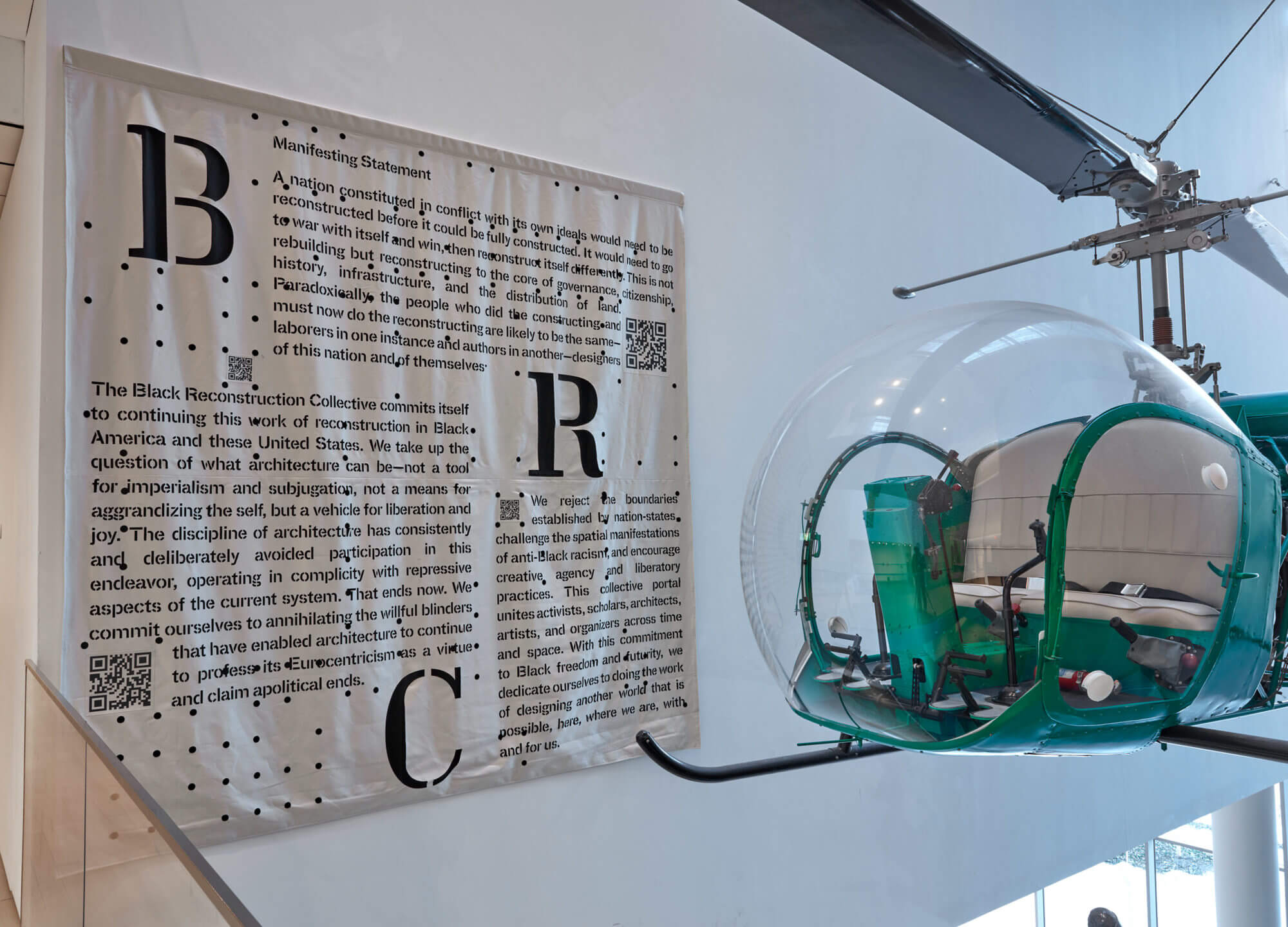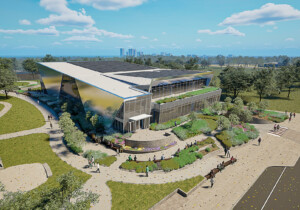The Museum of Modern Art (MoMA) has yet to take fully-realized steps to strip the name of the late architect and institutional figurehead Philip Johnson from all titles and public spaces at the museum at the demand of seven artists, architects, and designers—all featured in the Reconstructions: Architecture and Blackness in America exhibition—due to Johnson’s troubling (yet often skimmed-over) history of racist and anti-Semitic activities.
And it remains unclear how, when, and if the museum will do so, although a statement provided to AN by a MoMA spokesperson did reveal that the museum “currently has underway a rigorous research initiative to explore in full the allegations against Johnson and gather all available information. This work is ongoing.”
While only a temporary fix for now, signage introducing museum visitors to the “Philip Johnson Galleries” where the Reconstructions exhibition is being held is now covered with a large collaborative textile piece created by the ten participants featured in exhibition, all members of the nonprofit Black Reconstructive Collective (BRC). As first reported by Hyperallergic, the Johnson signage will be obscured through the run of Reconstructions. (You can read Jess Myers’ preview of the exhibition for AN here).

“To move forward with the exhibition thoughtfully, honoring the communities that the artists and their works represent, we feel it’s appropriate to respect the exhibition design suggestion and cover the signage with Johnson’s name outside the Architecture and Design galleries on an interim basis,” elaborated the MoMA statement. “The work is printed on denim and visualizes the BRC’s Manifesting Statement, which imagines how Black architects, designers, and artists move forward.”
As Felecia Davis, a founding member and executive officer of BRC, explained to AN in an email, the collaborative work—the only group work featured in Reconstructions—was originally planned to be installed elsewhere within the gallery.
“The decision to cover Philip Johnson’s name with the BRC manifesting textile came about after the BRC met as a group to decide how to remove Johnson’s legacy from our show to ensure the focus of the show was Blackness and Architecture in America, not Philip Johnson,” said Davis, who is an associate professor at the Stuckeman Center for Design Computing in the School of Architecture and Landscape Architecture at Pennsylvania State University and director of SOFTLAB@PSU.
“We saw his name at the entry to our exhibition galleries and decided to cover it with our textile so that it would not be the announcement to our work. In this way the textile was made quite useful. It was not planned for that,” Davis added. “We then met with MoMA, actually during the insurrection in D.C. MoMA was supportive of the covering idea.”
The “allegations against Johnson” mentioned by MoMA don’t exactly spring from a newfound revelation, as the fascist leanings of the inaugural Pritzker Prize laureate and former MoMA trustee-slash-patron-slash-curator are the stuff of abhorrent legend. Noting Johnson’s “widely documented white supremacist views and activities,” a November 27 open letter addressed in part to MoMA not only called for the honorific use of his name to cease but further detailed the architect’s worldview—a worldview that, per the letter, renders him “an inappropriate namesake within any educational or cultural institution that purports to serve a wide public.”
“There is a role for Johnson’s architectural work in archives and historic preservation,” the letter said. “However, naming titles and spaces inevitably suggests that the honoree is a model for curators, administrators, students and others who participate in these institutions.”
Initiated and first published by the Johnson Study Group, the letter was initially signed by a total of 31 artists, architects, designers, and educators including the aforementioned seven BRC members. They included, in addition to Davis, Sekou Cooke, Emanuel Admassu, Olalekan Jeyifous, Germane Barnes, J. Yolande Daniels, and V. Mitch McEwen, an architect and educator who is also a member of the largely anonymous Johnson Study Group.
In addition to MoMA, the letter was also addressed to Johnson’s alma mater, the Harvard Graduate School of Design (GSD). Just days after the Johnson Study Group letter was published and shared throughout architecture and design media, Harvard GSD dean Sara Whiting responded with her own letter stating that a Cambridge residence designed by Johnson while a graduate student would no longer be referred to using his surname. The GSD-owned property does not name Johnson on any sort of signage and, according to Whiting’s letter, “doesn’t have an official name on record, although it is usually referred to as the Thesis House, or the Philip Johnson Thesis House, or some variation.”
“But I fully agree with your strong point about the power of institutional naming, and the integrity and legitimacy it confers,” added Whiting. “And so we are taking steps to officially recognize the house within the university as simply ‘9 Ash Street’–the house’s physical address.”
Back at MoMA, one of the more conspicuous reminders of Johnson’s ties with the museum will be out of public view until May 31 when, as mentioned, Reconstructions closes. As detailed in the MoMA statement, the signage-obscuring work created by the BRC measures ten-feet-by-ten-feet and is the first work created for the exhibition that guests will see before entering the design galleries.
“We hope that the MoMA board will support the meaning of the act of covering and the content written on the cover and permanently remove his name from their galleries,” said Davis.
This article has been amended to include further insight from BRC member Felecia Davis.











